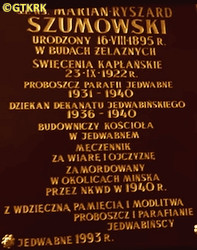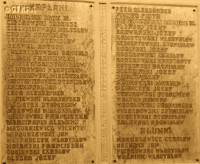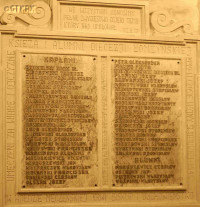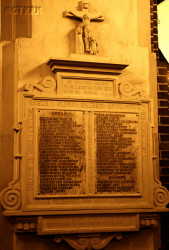Roman Catholic
St Sigismund parish
05-507 Słomczyn
85 Wiślana Str.
Konstancin deanery
Warsaw archdiocese, Poland
full list:
displayClick to display full list

searchClick to search full list by categories
wyświetlKliknij by wyświetlić pełną listę po polsku

szukajKliknij by przeszukać listę wg kategorii po polsku

Martyrology of the clergy — Poland
XX century (1914 – 1989)
personal data

surname
SZUMOWSKI
forename(s)
Marian Richard (pl. Marian Ryszard)
function
diocesan priest
creed
Latin (Roman Catholic) Church RCmore on
en.wikipedia.org
[access: 2014.09.21]
diocese / province
Łomża diocesemore on
www.kuria.lomza.pl
[access: 2012.11.23]
Sejny diocesemore on
www.catholic-hierarchy.org
[access: 2021.12.19]
RC Military Ordinariate of Polandmore on
en.wikipedia.org
[access: 2014.12.20]
honorary titles
honorary canonmore on
honorary canon
„Cross of Valour”more on
„Cross of Valour”
(c. 1944, prob., posthumously, awarded by the commander of the Białystok District of the Home Army_AK)
date and place
of death
27.01.1941

Minsktoday: Minsk city reg., Belarus
more on
en.wikipedia.org
[access: 2020.07.31]
alt. dates and places
of death
02.1941, 03.1941, 06.1941 (after)
Kuropatywilderness, forest complex
today: on the border of Minsk, Barauliany ssov., Minsk dist., Minsk city reg., Belarus
more on
en.wikipedia.org
[access: 2023.01.18]
on Minsk‐Chervyen roadtoday: Minsk reg., Belarus
more on
en.wikipedia.org
[access: 2022.07.16]
details of death
After German and Russian invasion of Poland in 09.1939 and start of the World War II arrested by the Germans participant of clandestine resistance Armed Struggle Union ZWZ (part of later Polish Clandestine Army) under nom‐de‐guerre „Driver”.
Arrested on 10.07.1940 in his parish Jedwabne — prob. in the aftermath of infiltration of the organization by the Russians (according to some sources through infiltration of the organization by a Jewish agent provocateur Epstein — in Jedwabne region Jews were by far the largest group collaborating with Russians) and crashing by the Russians of the Polish partisans' base camp in Kobielno — together with c. 250 partisans and resistance fighters, including Fr Stanislav Cudnik.
Taken to Łomża where a temporary selection camp was located.
From there transported to Minsk.
There tortured.
One of the victims, who shared a cell in Minsk with a priest, wrote in his memoirs: „In Jedwabne we were interrogated by the Jews, in Łomża — by the Jews, in Białystok — by the Jews, and in Minsk — by the Jews […] The beatings were unmerciful. Interrogations were conducted twice, and often three times a day”.
On 27.01.1941 sentenced to death prob. by a genocidal Special Council NKVD kangaroo court (known as «NKVD Troika»).
Murdered.
The aforementioned witness wrote: „One day the priest did not return from the interrogation, we knew that he had been shot”.
His name is supposedly on the so‐called „Belarusian Katyn list”. Such a list ‐ it should contained at least 3,870 names, according to the so‐called note by Alexander Shelepin, head of the Russian KGB, from 1959 — in connection with the obvious obstruction of the authorities of Russia and Belarus, has not yet been found.
alt. details of death
According to some sources sentenced to death together with Fr Stanislav Cudnik, among others.
In 02.1941 or 03.1941 marched out of the death cell and murdered with Fr Cudnik — prob. in Minsk prison.
According to other sources perished during the „death march” — after German invasion in 06.1941of their erstwhile ally Russia — of Minsk prisoners rushed by Russians east, in Chervyen direction.
cause of death
mass murder
perpetrators
Russians
sites and events
KurapatyClick to display the description, Minsk‐Chervyen „death march”Click to display the description, MinskClick to display the description, Ribbentrop‐MolotovClick to display the description, Pius XI's encyclicalsClick to display the description
date and place
of birth
16.08.1885

Budy Żelaznetoday: Mały Płock gm., Kolno pov., Podlaskie voiv., Poland
more on
en.wikipedia.org
[access: 2021.10.09]
alt. dates and places
of birth
16.01.1895, 04.04.1895, 16.06.1896, 16.07.1895
presbyter (holy orders)
ordination
23.09.1922

positions held
1936 – 1940
dean — Jedwabnetoday: Jedwabne gm., Łomża pov., Podlaskie voiv., Poland
more on
en.wikipedia.org
[access: 2022.05.23] RC deanery
1931 – 1940
parish priest — Jedwabnetoday: Jedwabne gm., Łomża pov., Podlaskie voiv., Poland
more on
en.wikipedia.org
[access: 2022.05.23] ⋄ St James the Apostle RC parish ⋄ Jedwabnetoday: Jedwabne gm., Łomża pov., Podlaskie voiv., Poland
more on
en.wikipedia.org
[access: 2022.05.23] RC deanery
1928 – 1931
parish priest — Halynkatoday: Sapotskin ssov., Grodno dist., Grodno reg., Belarus
more on
be.wikipedia.org
[access: 2022.07.16] ⋄ Exaltation of the Holy Cross RC parish ⋄ Teolintoday: part of Sapotskin, Sapotskin ssov., Grodno dist., Grodno reg., Belarus
more on
en.wikipedia.org
[access: 2020.11.27] RC deanery
1924 – c. 1928
vicar — Łomżatoday: Łomża city pov., Podlaskie voiv., Poland
more on
en.wikipedia.org
[access: 2022.01.28] ⋄ St Michael the Archangel RC parish ⋄ Łomżatoday: Łomża city pov., Podlaskie voiv., Poland
more on
en.wikipedia.org
[access: 2022.01.28] RC deanery
vicar — Puchałytoday: Łomża gm., Łomża pov., Podlaskie voiv., Poland
more on
en.wikipedia.org
[access: 2021.12.18] ⋄ St Adalbert the Bishop and Martyr RC parish ⋄ Łomżatoday: Łomża city pov., Podlaskie voiv., Poland
more on
en.wikipedia.org
[access: 2022.01.28] RC deanery
1923
vicar — Wąsosztoday: Wąsosz gm., Grajewo pov., Podlaskie voiv., Poland
more on
en.wikipedia.org
[access: 2022.07.16] ⋄ Transfiguration of the Lord RC parish ⋄ Wąsosztoday: Wąsosz gm., Grajewo pov., Podlaskie voiv., Poland
more on
en.wikipedia.org
[access: 2022.07.16] RC deanery
1922 – 1923
student — Warsawtoday: Warsaw city pov., Masovia voiv., Poland
more on
en.wikipedia.org
[access: 2021.10.09] ⋄ theology, University of Warsaw [i.e. University of Warsaw (from 1945) / clandestine University (1939‐1945) / Joseph Piłsudski University (1935‐1939) / University of Warsaw (1915‐1935) / Imperial University of Warsaw (1870‐1915)]
1919 – 1922
student — Łomżatoday: Łomża city pov., Podlaskie voiv., Poland
more on
en.wikipedia.org
[access: 2022.01.28] ⋄ philosophy and theology, Theological Seminary
others related
in death
CUDNIKClick to display biography Stanislav, GOJClick to display biography John, RADWAŃSKIClick to display biography Joseph John, CIEŚLAClick to display biography Felix, JASTRZĘBSKIClick to display biography Stanislav, KUREKClick to display biography Stanislav, MALINOWSKIClick to display biography Clement, STANISŁAWSKIClick to display biography Steven Thaddeus, SZCZERBICKIClick to display biography Fabian, ŻURAWSKIClick to display biography Ceslav, ŻYLIŃSKIClick to display biography Boleslav
sites and events
descriptions
Kurapaty: Forest near Minsk in Belarus, where mass graves of victims murdered by the Russian genocidal NKVD organization in the years 1937—1941 were discovered. It is also the place where these murders were carried out — in addition to human remains, shell casings and bullets were also discovered there. The NKVD genociders brought there, in closed cars, convicts and shot them there. Murders were also carried out in other places in Minsk, including prob. of Poles — as part of the «Katyn Genocide 1940», and their bodies were supposedly buried in Kurapaty. Estimates of the number of murdered range from 7,000 (the version of the Prosecutor General of Belarus) to 250,000 or even more. For decades, the Belarusian authorities have been sabotaging efforts to thoroughly investigate the site of the genocide. The archives are classified. In school textbooks published in Belarus after 2000 there is not a word about Kurapaty. (more on: en.wikipedia.orgClick to attempt to display webpage
[access: 2023.01.18])
Minsk‐Chervyen „death march”: After German attack on 22.06.1941 of their erstwhile ally, Russians, the latter on 24.06.1941 started evacuation of two prisons in Minsk where many Poles, members of Polish clandestine resistance Armed Struggle Union ZWZ organization (part of future Polish Clandestine State), among others — Lithuanians, Belarusians — were held. Some of the prisoners — altogether a dozen or so thousands — were murdered in Minsk itself. The rest were marched in groups along the road towards Mogilev (c. 200 km). The murderers started from the outset — Russians shot with guns those deemed week. The bodies were left in ditches by the roadside. Chervyen (c. 60 km from Minsk) the column of prisoners — then only c. 2,000 strong — reached after 4 days. There, in a nearby forest, Russians murdered another few hundred of them. Only few dozen survived — thanks to German aerial bombing raid that forced Russians to flee. (more on: pl.wikipedia.orgClick to attempt to display webpage
[access: 2018.09.02])
Minsk: Russian prison. In 1937 site of mass murders perpetrated by the Russians during a „Great Purge”. After Russian invasion of Poland in 09.1939 and start of the World War II place of incarceration of many Poles, In 06.1941, under attack by Germans, Russians murdered there a group of Polish prisoner kept in Central and co‐called American prisons in Mińsk. The rest were driven towards Chervyen in a „death march” (10,000‐20,000 prisoners perished), into Russia. (more on: pl.wikipedia.orgClick to attempt to display webpage
[access: 2013.08.17])
Ribbentrop‐Molotov: Genocidal Russian‐German alliance pact between Russian leader Joseph Stalin and German leader Adolf Hitler signed on 23.08.1939 in Moscow by respective foreign ministers, Mr. Vyacheslav Molotov for Russia and Joachim von Ribbentrop for Germany. The pact sanctioned and was the direct cause of joint Russian and German invasion of Poland and the outbreak of the World War II in 09.1939. In a political sense, the pact was an attempt to restore the status quo ante before 1914, with one exception, namely the „commercial” exchange of the so‐called „Kingdom of Poland”, which in 1914 was part of the Russian Empire, fore Eastern Galicia (today's western Ukraine), in 1914 belonging to the Austro‐Hungarian Empire. Galicia, including Lviv, was to be taken over by the Russians, the „Kingdom of Poland” — under the name of the General Governorate — Germany. The resultant „war was one of the greatest calamities and dramas of humanity in history, for two atheistic and anti‐Christian ideologies — national and international socialism — rejected God and His fifth Decalogue commandment: Thou shall not kill!” (Abp Stanislav Gądecki, 01.09.2019). The decisions taken — backed up by the betrayal of the formal allies of Poland, France and Germany, which on 12.09.1939, at a joint conference in Abbeville, decided not to provide aid to attacked Poland and not to take military action against Germany (a clear breach of treaty obligations with Poland) — were on 28.09.1939 slightly altered and made more precise when a treaty on „German‐Russian boundaries and friendship” was agreed by the same murderous signatories. One of its findings was establishment of spheres of influence in Central and Eastern Europe and in consequence IV partition of Poland. In one of its secret annexes agreed, that: „the Signatories will not tolerate on its respective territories any Polish propaganda that affects the territory of the other Side. On their respective territories they will suppress all such propaganda and inform each other of the measures taken to accomplish it”. The agreements resulted in a series of meeting between two genocidal organization representing both sides — German Gestapo and Russian NKVD when coordination of efforts to exterminate Polish intelligentsia and Polish leading classes (in Germany called «Intelligenzaktion», in Russia took the form of Katyń massacres) where discussed. Resulted in deaths of hundreds of thousands of Polish intelligentsia, including thousands of priests presented here, and tens of millions of ordinary people,. The results of this Russian‐German pact lasted till 1989 and are still in evidence even today. (more on: en.wikipedia.orgClick to attempt to display webpage
[access: 2015.09.30])
Pius XI's encyclicals: Facing the creation of two totalitarian systems in Europe, which seemed to compete with each other, though there were more similarities than contradictions between them, Pope Pius XI issued in 03.1937 (within 5 days) two encyclicals. In the „Mit brennender Sorge” (Eng. „With Burning Concern”) published on 14.03.1938, condemned the national socialism prevailing in Germany. The Pope wrote: „Whoever, following the old Germanic‐pre‐Christian beliefs, puts various impersonal fate in the place of a personal God, denies the wisdom of God and Providence […], whoever exalts earthly values: race or nation, or state, or state system, representatives of state power or other fundamental values of human society, […] and makes them the highest standard of all values, including religious ones, and idolizes them, this one […] is far from true faith in God and from a worldview corresponding to such faith”. On 19.03.1937, published „Divini Redemptoris” (Eng. „Divine Redeemer”), in which criticized Russian communism, dialectical materialism and the class struggle theory. The Pope wrote: „Communism deprives man of freedom, and therefore the spiritual basis of all life norms. It deprives the human person of all his dignity and any moral support with which he could resist the onslaught of blind passions […] This is the new gospel that Bolshevik and godless communism preaches as a message of salvation and redemption of humanity”… Pius XI demanded that the established human law be subjected to the natural law of God , recommended the implementation of the ideal of a Christian state and society, and called on Catholics to resist. Two years later, National Socialist Germany and Communist Russia came together and started World War II. (more on: www.vatican.vaClick to attempt to display webpage
[access: 2023.05.28], www.vatican.vaClick to attempt to display webpage
[access: 2023.05.28])
sources
personal:
www.geocities.wsClick to attempt to display webpage
[access: 2018.09.02], www.ogrodywspomnien.plClick to attempt to display webpage
[access: 2018.09.02], www.cda.plClick to attempt to display webpage
[access: 2021.10.09], lomzynskie24.plClick to attempt to display webpage
[access: 2013.12.04], www.naszawitryna.plClick to attempt to display webpage
[access: 2014.07.11]
bibliographical:
„Lexicon of Polish clergy repressed in USSR in 1939‐1988”, Roman Dzwonkowski, SAC, ed. Science Society KUL, 2003, Lublin
original images:
www.youtube.comClick to attempt to display webpage
[access: 2023.08.31], ipn.gov.plClick to attempt to display webpage
[access: 2019.02.02]
LETTER to CUSTODIAN/ADMINISTRATOR
If you have an Email client on your communicator/computer — such as Mozilla Thunderbird, Windows Mail or Microsoft Outlook, described at WikipediaPatrz:
en.wikipedia.org, among others — try the link below, please:
LETTER to CUSTODIAN/ADMINISTRATORClick and try to call your own Email client
If however you do not run such a client or the above link is not active please send an email to the Custodian/Administrator using your account — in your customary email/correspondence engine — at the following address:

giving the following as the subject:
MARTYROLOGY: SZUMOWSKI Marian Richard
To return to the biography press below:
 Click to return to biography
Click to return to biography












